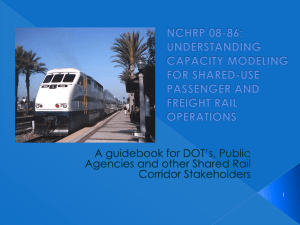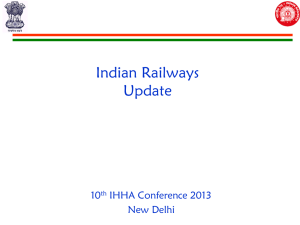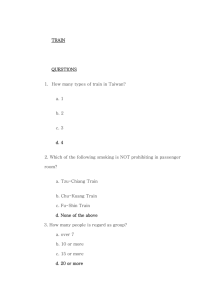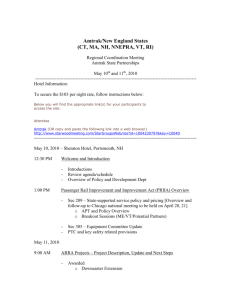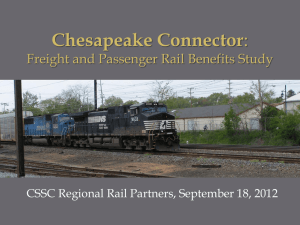“Because of a market-based approach involving minimal
advertisement
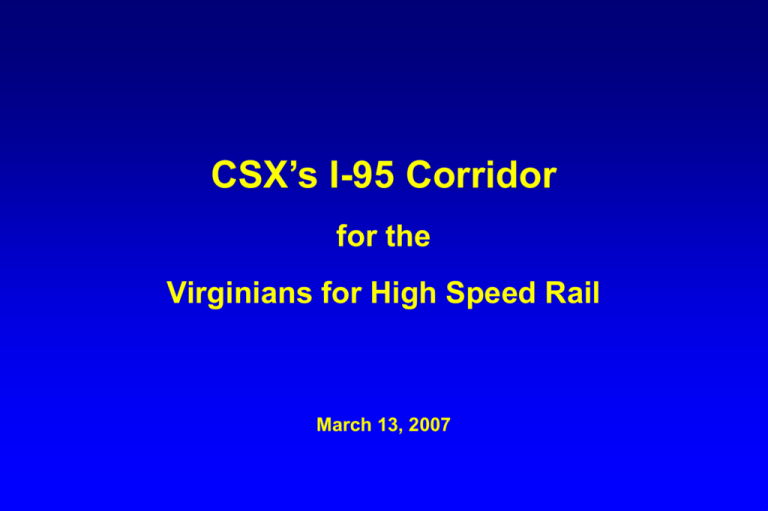
CSX’s I-95 Corridor for the Virginians for High Speed Rail March 13, 2007 Today’s discussion: Provide an overview of CSX’s I-95 Corridor in Virginia Discuss Amtrak performance Review actions to improve performance Update construction projects In depth look at the Quantico Bridge cut-in The path to the Corridor of the Future and to the funding 2 On-time performance of Amtrak trains is largely dependent on three factors. Physical characteristics of the operating territory Single/double track? Signal System? The operating mix of train traffic How many trains? What kinds of trains? The validity of schedules Can they be reliably maintained? Do they adjust for known activities? 3 CSX’s DC to Richmond corridor is our busiest multi-use, double track corridor and one of the busiest in the US. ~110 miles of double track with centralized traffic control (CTC) 48 Daily passenger/commuter trains 18 Amtrak trains 30 VRE commuter trains Washington Richmond Washington ~32 daily freight trains Richmond Over half the train slots filled by passenger trains And until recently, a single track bridge 4 Passenger operations outperform freight operations even with increased traffic and few capacity enhancements. Train Type VRE Amtrak Intermodal Merchandise Unit From Washington Washington Washington Washington Washington (CP (CP (CP (CP (CP VA) VA) VA) VA) VA) To Fredericksburg Richmond (Greendale) Richmond (Greendale) Richmond (Greendale) Richmond (Greendale) Distance 53.5 107.5 107.5 107.5 107.5 Avg Time 1:31 2:10 2:53 4:11 4:19 Deviation 0:12 0:19 0:40 1:31 1:26 MPH 35.1 49.3 37.1 25.7 24.9 The high standard deviations for freight trains mean poor reliability for freight customers Poor freight reliability means more highway congestion 5 CSX and BNSF have the lowest levels of freight train interference. Freight Interference by Road 1800 1600 1200 1000 800 BNSF CSX NS 600 UP 400 200 0 AP 5 R 05 M AY 0 JU 5 N 0 JU 5 L 0 AU 5 G 0 SE 5 P 05 O C T 0 NO 5 V 0 DE 5 C 0 JA 5 N 0 FE 6 B 06 M AR 0 AP 6 R 06 M AY 0 JU 6 L 0 AU 6 G 0 SE 6 P 06 O C T 0 NO 6 V 0 DE 6 C 0 JA 6 N 07 05 B AR M FE N 05 0 JA MIN. DELAY PER 10000 TRAIN MILES 1400 D A T A SOU R C E A M T R A K HOST D ELA Y R EPOR T ( N o June 0 6 D at a) 6 In 2005 and 2006, CSXT delays to Amtrak trains have been driven more by maintenance than by freight train delay. Maintenance of Way, Signal and Slow Order Caused Amtrak Delays Maintenance of Way, Signal, and Slow Order Caused Amtrak Delays 1600 1400 1000 BN CSX 800 NS UP 600 400 200 04 No v-0 4 De c-0 4 J an -0 5 Fe b- 0 5 Ma r- 0 5 Ap r- 0 5 Ma y -0 5 J un -0 5 J ul -05 Au g- 0 5 Se p- 0 5 Oc t- 0 5 No v-0 5 De c-0 5 J an -0 6 Fe b- 0 6 Ma r- 0 6 Ap r- 0 6 Ma y -0 6 J un -0 6 J ul -06 Au g- 0 6 Se p- 0 6 Oc t- 0 6 No v-0 6 De c-0 6 J an -0 7 0 Oc t- Delay Per 10,000 Train Mile 1200 Da t a S ourc e Amt ra k Host De la y Re port June 2 0 0 6 da t a not a va ila ble 7 CSX is completing a robust RF&P maintenance program. Invested $19 million in RF&P track structure in 2005 and 2006 Replaced 176,092 ties (138.2 track miles) 97,165 feet of rail (9.2 track miles) Another $10.5 M planned in 2007 Replacing 48,000 ties (43.68 track miles south of VRE service area) Replacing 78,000 feet of rail (14.74 miles) Investments benefit passenger service: Better ride and more reliable service However, tie replacement: Requires the removal of the rail anchors Breaks the surface friction between the ties and the ballast Destabilizes track, and Requires a conservative approach to heat. 8 Last summer’s passengers experienced significant delays; the root cause was a lack of capacity. The most severe delays resulted from a combination of causes Lack of capacity identified as the root cause of delays years ago June flooding set records Severe electrical storm caused catastrophic damage at Possum Point Traffic congestion due to booming economy Lack of capacity VRE agreement 1999 Federal Railroad Administration Report to Congress 2000 CANAC Line Capacity Study for Virginia, VRE and CSX MAROPS (Mid Atlantic Rail Ops Study - VA, FRA, FHWA, state DOTs, and Ports) Causes significant traffic congestion which inhibits reliability and growth Prevents recovery, regardless of the cause of the initial delay Few stations have platforms serving both tracks, resulting in a single track operation for VRE Only a small portion of the delays were attributable to heat orders Affects trains between 1 PM and 7 PM only 50 MPH, not 70 MPH, but multiple station stops limit the impact Maximum delay of 10 minutes for Fredericksburg riders; more for Richmond and Newport 9 News As responsible partners, we’ve taken a number of actions to improve performance as the capacity improvements are underway. Intensified tactical focus produces results Assigned experienced dispatchers to territory Added operations superintendent to network dispatch center to monitor daily operations Established new train manager for area Increased signal, track and mechanical maintenance presence on corridor Changed freight schedules for trains departing Richmond, Baltimore and Cumberland Partnering with Amtrak & VRE on major maintenance work Working nights to minimize disruptions when possible — Minimizes train cancellations — Less productive, more costly and more challenging for workers — But produces additional concerns during summer heat Establishing an experienced based, realistic schedule 10 The capacity enhancements will make a real difference, especially the opening of the Quantico Bridge. Phase One – Complete AF Interlocking Dispatcher Consolidation Phase Two – Complete Arkendale crossovers Elmont crossovers Phase Three – Underway L’Enfant 3rd main Phase Four – 2007/2008 Quantico Bridge (Feb. 2007) Slater’s Lane to RO (Design) Franconia 3rd main (Design) Phase Five – 2008 Fredericksburg to HA 3rd main (Design) 11 The new 2-track Quantico Bridge opened February 17. 12 P098 was the first train over the new Quantico Bridge. 13 The $30M Quantico cut-in involves far more than just the construction of a new bridge. P09816 0508 (Arkendale) 0608 (Featherstone) Segment 3 17-Feb SA thru 18-Feb SU (0700-0700 ??? hours) Single track Featherstone (87.0) to Arkendale (72.1) - 14.9 miles (Signals Suspended) Absolute Curfew February 17, 2007 1200 hours until 1400 hours -- after P079/89 Combo Saturday, February 17, 2007 Amtrak/VRE will have 2 T&E employees in the Locomotive Cab to copy DTC Blocks P05216 P06717 P08217 P08817 P09216 P08917 P07917 P19417 P19517 P09117 P05317 P08017 P09917 P09017 P06617 P09717 0723 (Arkendale) 0823 (Featherstone) Cancelled 0843 (Arkendale) 0943 (Featherstone) Cancelled 1036 (Arkendale) 1136 (Featherstone) Combine w P07917 1129 (Featherstone) 1229 (Arkendale) Cancelled Cancelled 1543 (Featherstone) 1643 (Arkendale) 1620 (Featherstone) 1720 (Arkendale) Combined w/P090 at Richmond on PO 90'S Schedule Cancelled 1846 (Arkendale) 1946 (Featherstone) P090 will depart Rich 1 hour later than scheduled due to switching P080 into consist Cancelled 2006 (Featherstone) 2106 (Arkendale) 14 In addition, the Rail Advisory Board is funding the preliminary engineering for 11 miles of 3rd main between Arkendale and Powells Creek. Increases capacity significantly Eliminates congestion at Quantico Creek Capitalizes on new Quantico Creek Bridge; from 1 to 3 tracks Complements on-going, publiclyfunded capacity improvements Includes a new Cherry Hill VRE station stop Uses match from a private developer 15 But the consensus finding is that major investments are needed to finish the project in three phases. Phase 1 Build the third main track from DC to Richmond now — Exclude the high cost projects — Seek the preliminary engineering needed for firm estimates Phase 2 Attack the challenging, high cost projects next — Major bridges • Potomac • Aquia — Ashland constraints — Fredericksburg viaduct Phase 3 Develop the Corridor of the Future — Sealed high-speed freight passenger separation — Expanded freight capacity 16 The DC to Richmond Third Track Feasibility Study provides the path for completion. Complete the VTA 2000 program of projects. Complete a comprehensive alternatives analysis Conduct operational modeling Review alternate right-of-ways Analyze public and private benefits Conduct an environmental review and the preliminary engineering Determine the specific design Develop accurate estimate of costs Establish agreements Identify a dedicated source of funding for capital and operating costs 17 Federal support is the key. Funding Federal appropriations (primary source of funding) 2008/9 Transportation Reauthorization Bill Corridors of the Future State Appropriations ~$100m spent by Commonwealth of VA ~$20m in VA transportation bill Local governments and other agencies (1995 VRE agreement to fund 3rd main) Amtrak CSX - right of way & existing improvements Benefits Intercity passenger capacity / reliability Commuter capacity / reliability Trucks off the highway Reduced highway congestion on I-95 Environmental benefits 18 CSX’s Corridor of the Future application may surprise you. Corridor stretches 1,200 miles from Washington to Miami. Corridor must be modified to address three major challenges Both passenger and freight trains need to travel faster Both passenger and freight trains need greater reliability and recoverability Both passenger and freight train volume will increase CSX’s vision for the future is: Passenger trains must be able to travel unimpeded at 110 MPH Freight trains must be able to operate at speeds of 50 MPH to 70 MPH Passenger service must be physically separated from freight operations — Higher density industrial areas may require freight tracks on both sides of passenger tracks The corridor must be sealed to prevent motor vehicle intrusion — 1700 at-grade highway rail crossings must be addressed 19 We must finish the project; the next steps are… Set realistic expectations during current construction Align stakeholders around a common plan Seek consensus and action on “Quick Hits” Perform preliminary engineering – refine cost estimates Organize and energize all stakeholders to advocate for these changes Gain federal support 20 Thanks for your attention. Questions? 21
